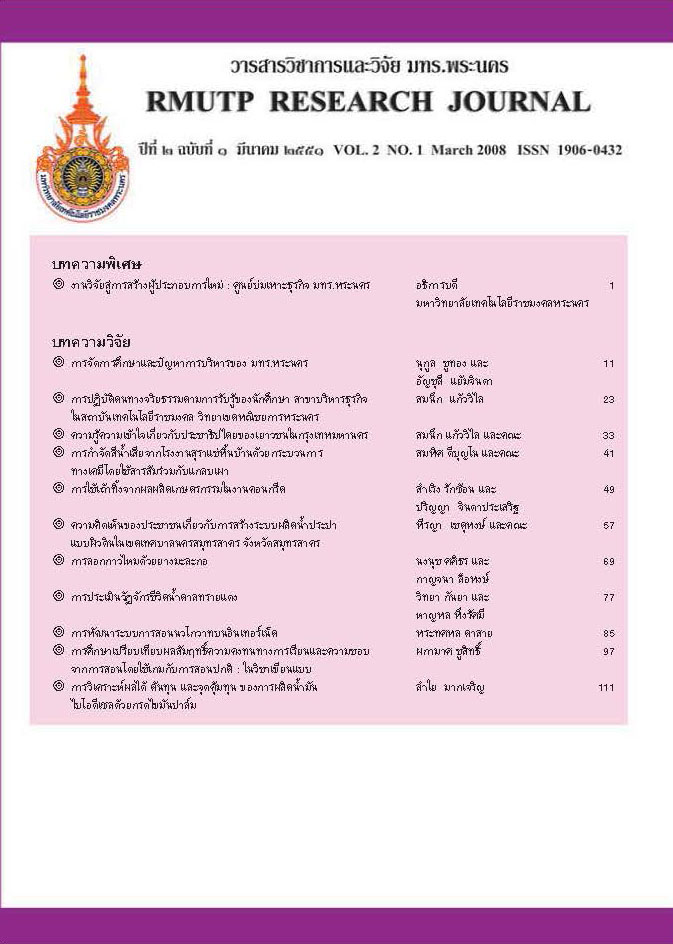การพัฒนาระบบการสอนนวโกวาทบนอินเทอร์เน็ต
Main Article Content
Abstract
บทคัดย่อ
การวิจัยนี้มีวัตถุประสงค์เพื่อ 1) พัฒนาระบบการสอนนวโกวาทบนอินเทอร์เน็ต 2) เพื่อศึกษาความ พึงพอใจของผู้เรียนที่มีต่อบทเรียน เครื่องมือที่ใช้ในการศึกษา ประกอบด้วย ระบบการสอนนวโกวาทบนอินเทอร์เน็ต และแบบประเมินความพึงพอใจของผู้เรียนที่มีต่อบทเรียน โดยศึกษากับกลุ่มตัวอย่างซึ่งเป็นนักเรียนชั้น มัธยมศึกษาปีที่ 6 ภาคเรียนที่ 1 ปีการศึกษา 2550 โรงเรียนบ้านกาดวิทยาคม อ.แม่วาง จังหวัดเชียงใหม่ จำนวน 150 คน ซึ่งได้มาจากวิธีการสุ่มอย่างง่าย ผลการศึกษาสูงสุด 3 อันดับ พบว่า บทเรียนสามารถใช้เป็นสื่อในการ เรียนการสอนวิชาพระพุทธศาสนาได้อยู่ในระดับมาก มีค่าเฉลี่ย 4.17 ค่าเบี่ยงเบนมาตรฐาน 0.78 การนำหลักธรรมในนวโกวาทไปประยุกต์ใช้ในชีวิตประจำวันอยู่ในระดับมาก มีค่าเฉลี่ยเท่ากับ 4.07 ค่าเบี่ยงเบนมาตรฐาน 0.77 และรูปแบบการนำเสนอน่าสนใจและน่าติดตามอยู่ในระดับมาก มีค่าเฉลี่ยเท่ากับ 3.93 ค่าเบี่ยงเบนมาตรฐาน 0.82 โดยผลการประเมินความพึงพอใจของผู้เรียนที่มิต่อบทเรียนที่พัฒนาขึ้นโดยรวมอยู่ในระดับมาก มิค่าเฉลี่ยเท่ากับ 3.84 ค่าเบี่ยงเบนมาตรฐาน 0.50 ซึ่งแสดงให้เห็นว่าระบบการสอนนวโกวาทบนอินเทอร์เน็ตที่พัฒนาขึ้น สามารถนำไปใช้ในการเรียนการสอนได้
Abstract
The purposes of this research were l) to develop an internet-based Navagovat learning system and 2) to evaluate the students’ satisfaction with the developed learning system. The tools used in the evaluation consisted of the developed learning system and the questionnaires. The evaluation process was carried on during the first semester with the sampling of 150 mathayom 6 students in Bankad Widthayacom School, Maewang district, Chiangmai using the simple random sampling method. The results from the evaluation process were rated with a very high satisfaction by the selected students and it could then be used in the real life application, the details of the evaluation results could be categorized into three different topics which could be listed consecutively as: The applicability of the learning system yielded the average of 4.17 with the standard deviation of 0.78; the application of the Navagovat teachings yielded the average of 3.93 with the standard deviation of 0.82; and the presentation format yielded the average of 3.84 with the standard deviation of 0.50.


